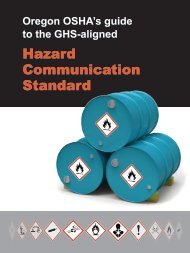Technical Manual - Section 3 (Safety Hazards)
Technical Manual - Section 3 (Safety Hazards)
Technical Manual - Section 3 (Safety Hazards)
You also want an ePaper? Increase the reach of your titles
YUMPU automatically turns print PDFs into web optimized ePapers that Google loves.
Figure III:3-1. Some Major Parts of a Pressure Vessel<br />
storage vessel or combined with a storage vessel into one<br />
unit.<br />
Typical operational conditions for deaerator vessels range up<br />
to about 300 psi and up to about 150 C (300 F). Nearly all<br />
of the vessels are designed to ASME Code resulting in vessel<br />
wall thicknesses up to but generally less than 25 mm (1 in).<br />
The vessel material is almost universally one of the carbon<br />
steel grades.<br />
Analysis of incident survey data and other investigations has<br />
determined the following features about the deaerator vessel<br />
cracking.<br />
The failures and the survey results have prompted TAPPI<br />
(<strong>Technical</strong> Association of Pulp and Paper Industry), the<br />
National Board of Boiler and Pressure Vessel Inspectors, and<br />
NACE (National Association of Corrosion Engineers) to<br />
prepare inspection, operation and repair recommendations.<br />
For inspection, all recommendations suggest:<br />
@<br />
@<br />
Special attention to the internal surface of all welds<br />
and heat-affected zones (HAZ); and<br />
Use of the wet fluorescent magnetic particle (WFMT)<br />
method for inspection.<br />
@<br />
@<br />
@<br />
Water hammer is the only design or operational<br />
factor that correlates with cracking.<br />
Cracking is generally limited to weld regions of<br />
vessels that had not been postweld heat treated.<br />
Corrosion fatigue appears to be the predominant<br />
mechanism of crack formation and growth.<br />
The TAPPI and the NACE recommendations also contain<br />
additional items, such as:<br />
@<br />
Inspection by personnel certified to American Society<br />
for Nondestructive Testing's SNT-TC-1A minimum<br />
Level I and interpretation of the results by minimum<br />
Level II; and<br />
@ Reinspection within one year for repaired vessels, 1-2<br />
years for vessels with discontinuities but unrepaired,<br />
III:3-3
















